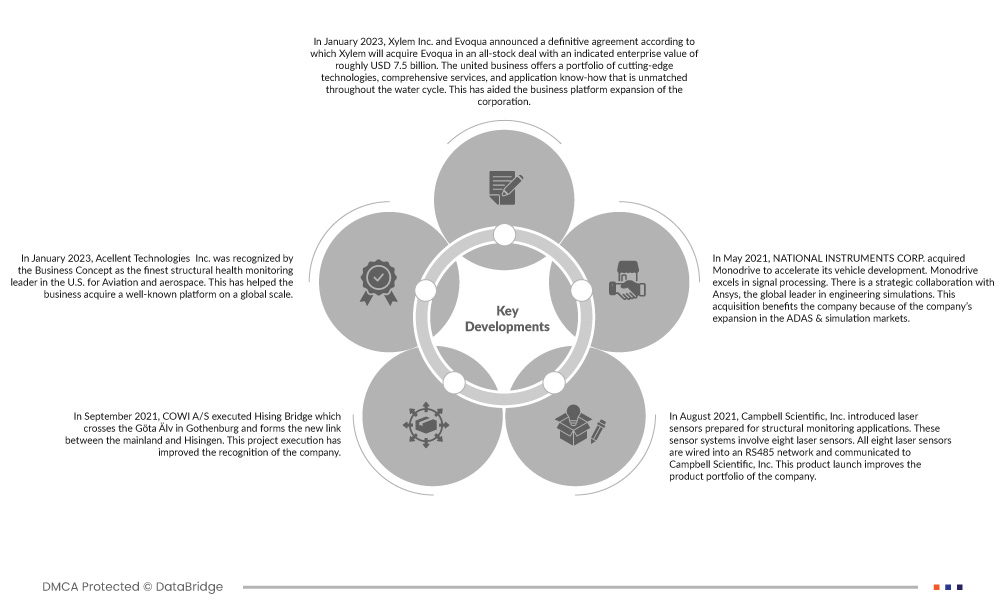Structural Health Monitoring (SHM) is a range of systems implemented on full-scale civil infrastructures to assist and inform operators about the continued ‘fitness for purpose’ of structures under gradual or sudden changes to their state and to learn about either or both of the load and response mechanisms.
The importance of infrastructure is widely recognized and well-researched. However, there have been relatively few attempts to track and monitor infrastructure investment across countries where studies have assessed Middle East and Africa infrastructure needs; the adoption of myriad definitions and approaches has consistently made monitoring trends difficult. The various initiatives and developments in infrastructure across the globe are expected to drive the growth of the Middle East and Africa structural health monitoring market.
Access Full Report @ https://www.databridgemarketresearch.com/es/reports/middle-east-and-africa-structural-health-monitoring-market
Data Bridge Market Research analyses that the Middle East and Africa Structural Health Monitoring Market is expected to reach USD 691.13 million by 2030 from USD 230.03 million in 2022, growing at a CAGR of 14.9% in the forecast period of 2023 to 2030.
Increasing Automation and Standardization in Maintenance & Repair of Civil Infrastructure
Today, the technologies of construction have changed, but not nearly to the same degree. Construction is the process of moving, and assembling materials and equipment into a completed, operational facility. Although many construction operations are repetitive, they are performed neither in a fixed sequence nor at a fixed location. There are various complexities in construction development and maintenance, but the emergence of automation facilities provides an opportunity to predict the technological problems that are to be caused and the solution that is to be carried out. The increase in the implementation of standardized automation systems requires structural health monitoring systems to be installed in critical structures, which marks the need for SHM systems in automation, maintenance, and repair of civil infrastructure.
Report Scope and Market Segmentation
|
Report Metric
|
Details
|
|
Forecast Period
|
2023 to 2030
|
|
Base Year
|
2022
|
|
Historic Years
|
2021 (Customizable tot 2015-2020)
|
|
Quantitative Units
|
Revenue in USD Million
|
|
Segments Covered
|
Type (Hardware, Software, and Services), Connectivity (Wired and Wireless), Installation Type (New installation and Retrofit), Method (Visual Inspection and Non-Destructive Evaluation (NDE)), Application (Damage Detection, Crack Detection, Strain Monitoring, Wire Break Monitoring, Leakage Detection, Multimodal Sensing, Corrosion Monitoring, Hotspot Monitoring, Impact Monitoring, and Deflection Monitoring), End User (Civil, Aerospace, Energy, Mining, Marine, Industrial, Offshore Platform, Defense, School, Public Park and Recreation, Automotive, and Others)
|
|
Countries Covered
|
South Africa, Saudi Arabia, Bahrain, U.A.E., Kuwait, Oman, Qatar, Egypt, Israel and rest of Middle East and Africa
|
|
Market Players Covered
|
GEOKON (U.S.), Campbell Scientific, Inc. (U.S.), SIXENSE Systems (France), Kinemetrics (U.S.), NATIONAL INSTRUMENTS CORP. (U.S.), OSMOS Group SA (A subsidiary of Eren Group) (France), HBK (Germany), James Fisher and Sons plc (U.K.), GoeSIG Ltd (Switzerland), Xylem Inc. (Canada), and Sisgeo S.r.l. (Italy) among others
|
|
Data Points Covered in the Report
|
In addition to the market insights such as market value, growth rate, market segments, geographical coverage, market players, and market scenario, the market report curated by the Data Bridge Market Research team includes in-depth expert analysis, import/export analysis, pricing analysis, production consumption analysis, and pestle analysis
|
Segment Analysis
The Middle East and Africa structural health monitoring market is segmented into six notable segment based on type, connectivity, installation type, method, application, and end user.
- On the basis of type, the Middle East and Africa structural health monitoring market is segmented into hardware, software, and services
In 2023, the hardware segment is expected to dominate the Middle East and Africa Structural Health Monitoring Market
In 2023, the hardware segment is expected to dominate the market with a market share of 57.80 due to the increasing utilization of novel technologies such as sensors for health monitoring, making it easy to assess the level of damage at an early stage of the structures life.
- On the basis of connectivity, the Middle East and Africa structural health monitoring market is segmented into wired and wireless
In 2023, the wired segment is expected to dominate the Middle East and Africa Structural Health Monitoring Market
In 2023, the wired segment is expected to dominate the market with a market share of 75.82% due to the integration of technologically advanced solutions and the safety and maintainability of critical civil structures.
- On the basis of installation type, the Middle East and Africa structural health monitoring market is segmented into new installation and retrofit. In 2023, the new installation segment is expected to dominate the market with a market share of 68.33%
- On the basis of method, the Middle East and Africa structural health monitoring market is segmented into visual inspection and non-destructive evaluation (NDE). In 2023, the visual inspection segment is expected to dominate the market with a market share of 68.89%
- On the basis of application, the Middle East and Africa structural health monitoring market is segmented into damage detection, crack detection, strain monitoring, wire break monitoring, leakage detection, multimodal sensing, corrosion monitoring, hotspot monitoring, impact monitoring, and deflection monitoring. In 2023, the damage detection segment is expected to dominate the market with a market share of 44.28%
- On the basis of end user, the Middle East and Africa structural health monitoring market is segmented into civil, aerospace, energy, mining, marine, industrial, offshore platform, defense, schools, public parks and recreation, automotive, and others. In 2023, the civil segment is expected to dominate the market with a market share of 42.82%
Major Players
Data Bridge Market Research recognizes the following companies as the major structural health monitoring players in the Middle East and Africa structural health monitoring market are GEOKON (U.S.), Campbell Scientific, Inc. (U.S.), HBK (Germany), James Fisher and Sons plc (U.K.), Xylem Inc. (Canada).
Market Developments
- In January 2023, Xylem Inc. and Evoqua announced a definitive agreement according to which Xylem will acquire Evoqua in an all-stock deal with an indicated enterprise value of roughly USD 7.5 billion. The united business offers a portfolio of cutting-edge technologies, comprehensive services, and application know-how that is unmatched throughout the water cycle. This has aided the business platform expansion of the corporation
- In January 2023, Acellent Technologies Inc. was recognised by the Business Concept as the finest structural Health Monitoring leaders in the USA for Aviation and aerospace. This has helped the business acquire a well-known platform on a Middle East and Africa scale
- In September 2021, COWI A/S executed Hising Bridge which crosses the river Göta Älv in Gothenburg and forms the new link between the mainland and Hisingen. This project execution has improved the recognition of the company
- In August 2021, Campbell Scientific, Inc. introduced laser sensors prepared for structural monitoring application. These sensors systems involve eight laser sensors. All eight laser sensors are wired in an RS485 network and communicate to Campbell Scientific, Inc. This product launch improves the product portfolio of the company
- In May 2021, NATIONAL INSTRUMENTS CORP. acquired Monodrive to accelerate its vehicle development. Monodrive excels in signal processing. There is a strategic collaboration with Ansys, the Middle East and Africa leader in engineering simulations. The company is benefitted by this acquisition because the company’s expand in the ADAS & simulation markets
Regional Analysis
Geographically, the countries covered in the Middle East and Africa structural health monitoring market report are South Africa, Saudi Arabia, Bahrain, U.A.E., Kuwait, Oman, Qatar, Egypt, Israel and rest of Middle East and Africa.
As per Data Bridge Market Research analysis:
U.A.E. is the dominant region in the Middle East and Africa Structural Health Monitoring Market
U.A.E. is expected to dominate the Middle East and Africa structural health monitoring market due to the high technology adoption rate in all technology segments. In addition, the availability of aging infrastructure and companies dedicated to R&D in the structural health monitoring field make it an attractive investment destination for the structural health monitoring market.
For more detailed information about the Middle East and Africa structural health monitoring market, click here – https://www.databridgemarketresearch.com/es/reports/middle-east-and-africa-structural-health-monitoring-market














